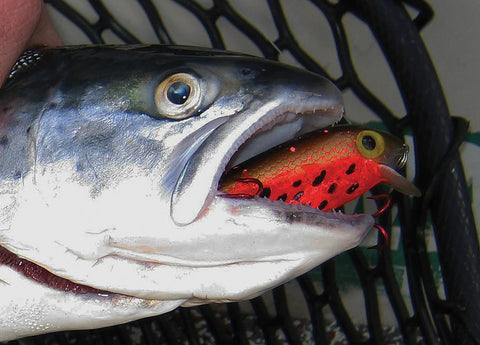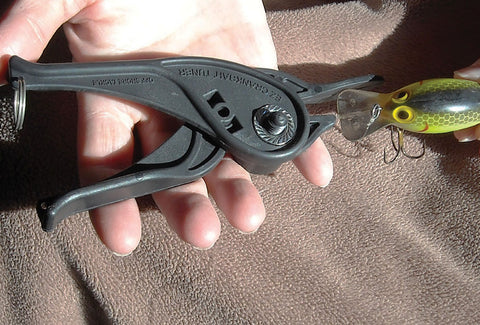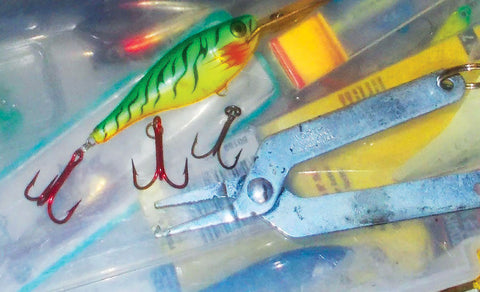Whether it’s a Sharpie, an assortment of model car paint colors or an airbrush set-up with a wild rainbow of colors, customizing crankbaits to suit your fancy—and hopefully to attract more fish—is an interesting hobby.

Bananas on a fishing trip is widely regarded to bring bad luck—or not!
This brown trout fell for a crankbait tweaked with stronger hooks and Sharpie dots.
I had an uncle who worked in the R&D department for McDonalds. For a couple years he worked to bring the McPizza to the golden arches. Well, that didn’t work, but after that project was scrapped, he had more success with the McRib, a menu item which still shows up at most McDonald’s franchises at least annually.
It’s a long process to go from being an idea in someone’s head to being on the menu at McDonald’s restaurants across the country. Each of these projects kept Uncle Jim employed for a couple of years. It’s a science. My uncle told me they tested hundreds of BBQ sauce recipes, the number of pickles and every other component of the McRib over and over again before it ever hit the stores. This effort makes most new “McProducts” an almost sure winner.
So, what’s this have to do with fishing; or specifically, fishing lures? Just this. When you head into a tackle shop to buy a crankbait, hear a report of the walleyes crushing Flicker Shads or your Yakima Mag Lips are doing the job on steelhead all day long, it’s not just because someone made a mold, slapped a coat of paint on the resulting lure body, added a couple of hooks and crossed their fingers that the fish (and the fishermen) would like them.
I know in the case of Flicker Shads (and I’m sure it’s the same for all of the other major brands of lures) there was as much research and development that went into them as goes into the food on the Mickey-D menu. I toured the Berkley factory decades ago when they were developing a then unnamed lure which ended up being the Flicker Shad. When I was there, they were testing the “action” of prototypes in long indoor pools filled with test fish. The lures were all painted black, each lure was pulled through the tanks with electric reels so every retrieve was identical.
I’m sure that later in the Flicker Shad’s development just as much attention was given to the finish and paint patterns. Eventually Berkley prostaff anglers beta-tested sizes, colors and offered suggestions. From the initial concept to shipping to tackle shops across the country was a multi-year process involving dozens of people and thousands of hours.
I’m also sure the Berkley’s “lure engineers” (and those from other lure makers) cringe when they see an article like this about how to “tweak” their lures to make them better. I know my uncle would have thumped my noggin if I told him I removed the pickles from one of “his” McRibs.

Adding stripes or spots to solid colored lures can boost their performance.
I don’t often tweak the Flicker Shads I use, but if I thought a slight or even a major alteration to one of them would make them better, I’d do it. I’m like guys who buy a brand-new Corvette, then add custom components to make it go faster, handle better or look even flashier. If they can mess with perfection, so can I.
HOOKS
One thing I often do with Flicker Shads (as well as many other crankbaits) is upsize/upgrade the hooks. At 3 1/2 inches in length, the #9 Flicker Shad is the same size and the same general shape as the alewives Great Lakes salmon and trout eat regularly.
But Flicker Shads weren’t designed with Great Lakes salmon and steelhead in mind. Sure, it’s possible to catch some of the biggest specimens in the lakes with straight out of the box Flicker Shads (or other similarly-sized plugs). The Fusion 19 trebles standard on Flicker Shads are sharp and well made, but are they up to the strike of a teener Skamania or the dogged determination of a mature Chinook?
Actually, you’ll catch most of the fish that bite your Flicker Shad (or other fresh out of the box crankbaits), but you’ll lose some due to bent out trebles or some that just come loose—a sign the smaller hook didn’t stick around the big fish’s jaw bone. The reason many saltwater plugs come with only a single hook or that hooks or plugs made specifically for salmon like J-Plugs normally have hooks in “ought” sizes is to make sure the hook latches securely around the jawbones, not just in the skin covering them.
I take a look at every crankbait I use when targeting big, tough salmon and trout with them and if the hooks don’t look to be strong enough or large enough, I swap them out. I’ve found most of the time moving up a few sizes—like going to a Size 2 treble instead of the standard size 4 on a #9 Flicker Shad and choosing hooks marked 2X or 3X strong will keep them from bending during the fight of a strong fish.
If you are unsure, test it. I have. I normally use 20-pound line for Great Lakes salmon and steelhead trolling so when I get a new model of crankbait with what appears to be a substandard set of hooks on it, I tie it on, hook the lure to something solid, then pull the line until something gives. If the line or knot breaks before the hook bends or breaks, great. If not, I swap them out with an extra-strength, perhaps larger hook.

Flicker Shads were perfected in these test tanks at the Berkley research facility.
These 2X hooks may get still get bent by thrashing fish in a landing net, but I know they aren’t going to straighten or break before the fish gets to the net. And if a hook does gets bent in the net, all I have to do is bend it back before putting the lure back in the game, right?
No, no, no—replace the hook. Any hook becomes weaker when it bends and even weaker when it’s bent back into shape. Actually, those 2X and 3X hooks are likely to break rather than bend.
I keep a small selection of hooks on the boat along with one of those inexpensive flat metal split ring pliers to quickly swap out a bent hook. Speaking of split rings....
All split rings are not created equal. That goes double for the split rings that go on crankbaits “normally” used for catching “lesser” fish.

Many crankbaits need to be fitted with stronger hardware to make them Great Lakes tough.
It’s not that the makers of these baits are trying to crank them out on the cheap. The last thing they want to do is get a reputation for making weakling lures. But remember, many of these lures aren’t designed for the size and strength of the fish in the Great Lakes. They are designed to be used around stumps, submerged brush and other underwater structure so attaching the hooks with small gauge split rings can be a lure saver. When I’m bass fishing with a squarebill crank around stumps or clumps, I’m be happy when I can pull a hook off one of those ten buck baits when it gets hung up, instead losing the whole lure.
There seems to be no industry standards when it comes to split rings. A size two from one could be a size four from another manufacturer. For salmon and steelhead, look for rings touted to be heavy duty, double strength or have some other indication they are built stronger. Many of the “name brand” companies like Owner and VMC advertise their rings with a “pound test” rating.
Fifty-pound test is the lightest I use. Not that I expect to catch a 50-pound fish, but I do expect a when a pissed-off Skamania is in my landing net, it can easily put 40 or 50 pounds of stress on the hooks and split rings before I can get the fish under control.

Every crankbait should be tuned when new and tested during use.
TUNING
If there’s only one tweak you do with your crankbaits, it should be to make sure they are swimming true. That holds whether they are being cast or trolled and regardless if they are targeting panfish or the biggest fish in the lakes. It’s easy to learn to bend the nose loop or line tie a smidge to the left or right to make sure the cranker swims with the top up and the bottom down. What many anglers find it difficult to learn is to check every crankbait they use every time they pull it out of the tackle box and then again after every fish is caught with it.
There are eight or ten different crank-bait models I use about ninety percent of the time. About half of them are designs that almost never need to be adjusted. I force myself to check them (most of the time) by pulling it along side the boat for a few seconds before sending it back into the game. Most pass the quick test but I find one needing a tweak once in a while. Other models commonly need an initial tune-up on their first use, then pretty well stay tuned after that or only need some tiny adjustments from time to time.
Then there are the “bad boys.” With these, I’m almost surprised when they don’t require bending the “nose towards the bottom” when new and after every fish. If it wasn’t that they do a good job of catching fish, they’d be out of the line-up.
I make a special effort to check the “tune” on any of the crankbaits I beef up with larger or stronger hooks and split rings. It’s rare that a split ring upgrade makes much of a difference, but upsizing hooks is a different story. It may take a bit of trial and error to find an upgrade that will work without upsetting the balance or significantly dampening the lure’s action.
COSMETIC TWEAKS
I once found an “overstock” bin in a tackle shop packed full of Storm Wiggle Warts in assorted colors, each at a bargain basement price. I couldn’t resist. I picked up several in what looked to me to be good colors, including both solid fluorescent red as well as fluorescent red with black stripes on the sides, reminiscent of rib bones. I used both the solid red and ribbed-red models for a few weeks and came to the realization that while both the solid red and ribbed-red Warts caught fish, the ones with the ribs out produced the solid red model.
With use, my supply of the ribbed-red Warts dwindled but instead of heading back to the store for a resupply, I found a Sharpie and inked on some rib-looking stripes on my solid red Warts. My artwork was less artistic than the factory-applied rib marks, but the fish didn’t seem to be that picky.

Many crankbaits need to be fitted with larger/stronger hooks.
That got me thinking about some of my “second tier” crankbaits that had a basically bland or solid color paint job. Would a bit of “Sharpie-magic” boost their performance? Sometimes, yes - just as with the Wiggle Warts, applying cosmetic ribs or some polka-dots seemed attract more strikes. Sometimes no. Evidently it wasn’t the presence or absence of “beauty marks” that made them more or less attractive.
But it never hurt a lure’s appeal. I never turned a solidly productive lure into a sure loser by adding stripes or dots.
Let your talents and imagination run wild. Whether it’s a Sharpie, an assortment of model car paint colors or an airbrush set-up with a wild rainbow of colors, customizing crankbaits to suit your fancy—and hopefully to attract more fish—is an interesting hobby.
RANDOM TWEAKS
There’s no limit on tweaks anglers can use or have used to make their crankbaits work better or at least to add some spice to a fishing trip by performing some interesting experiments.
One I tried years ago was adding Storm SuspenDots to various spots on crankbaits to change their action or depth. These dots were introduced decades ago to turn floating stickbaits, like Storm’s ThunderSticks into suspending models. The most interesting thing I did was to stick a couple of them on the bottom of the diving lip on deep divers to make them double-deep divers. It seemed to work on some models, on others they wrecked the action completely.
Luckily, the stick-on weighted dots aren’t permanent. I’ve also heard of guys wrapping small gauge lead or copper wire on hooks to alter the action of the lures.

Perhaps more hooks are bent in nets than in fish mouths.
I went through a “single hook” phase years ago when I swapped out the treble hooks on both spoons and crankbaits with larger-sized single hooks. I had both good results and bad with my trials. I’m back (mostly) to using trebles on my lures.
Years ago, Luhr Jensen’s J-Plugs didn’t come with rattles in them. I thought the addition of rattles made a good lure better and I thought the ones I drilled holes in, added some BBs to and then glued the hole shut worked better, too. Got any “rattle free” lures in your tackle box? Tweak them with some BBs.
Millions of fish have been caught with crankbaits right out of the box, with the original paint, with no change of hooks or any other user-applied tweak. The lure “engineers” designed them to work that way. But I believe it’s possible to make a good thing better. Just give it a little tweak.

MORE GREAT ARTICLES FROM AMATO MEDIA




